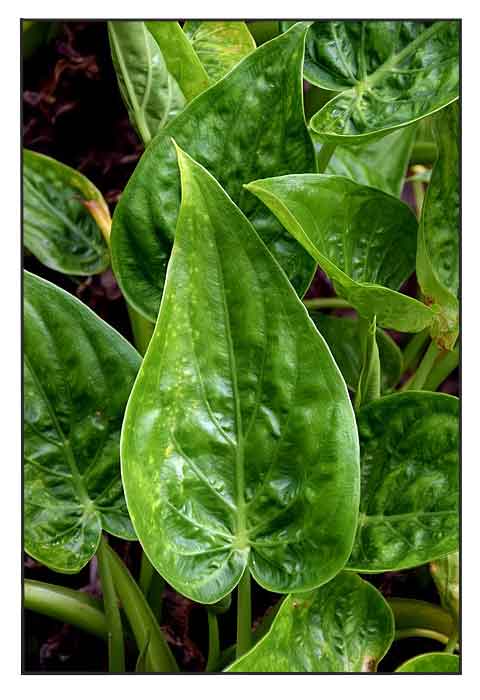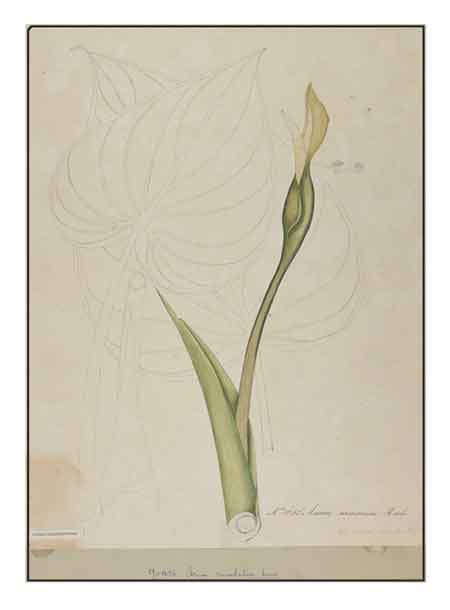 Gen info Gen info
- Alocasia cucullata is one of the oldest known species of Alocasia, published under the genus Arum in 1790, when the genus Alocasia did not exist yet. (2)
- Alocasia consists of about 65 species and has an Indo-Malesian distribution. In Malesia, 57 species are indigenous; Borneo, the main center of diversity, has about 23 species, 20 of which are endemic; the Philippines has 14 species, all endemic.
(3)
- Etymology:
The species epithet derives from Latin 'culcullatus', which means 'hooded', probably referring to the leaf shape. (2)
Botany
Alocasia cucullata is a clumping, small to medium-sized evergreen herbaceous plant, somewhat robust, to 1 m. Stems erect, hypogeal, basally much branched. Leaves many together; petiole weakly D-shaped in cross-section, 25-30 cm, sheath reaching to ca halfway, margins membranous; leaf blade broadly ovate-cordate, apex acute; primary veins 4 on each side, radiating from petiole, arching, interprimary veins not forming a collective vein. Inflorescences rarely produced, usually solitary, sometimes paired, among leaf bases, subtennded by membranous cataphylls; peduncle 20-30 cm. Spathe green, 9-15 cm; proximal spathe 4-8 x ca. 2.5 cm; limb narrowly cymbiform, 5-10 x 3-5 cm. Spadix 8-14 cm; female zone cylindric, 1.5-2.5 cm x ca. 7 mm; sterile zone 2-3 cm x ca. 3mm; male zone yellow, ca. 3.4 cm x 8 mm; appendix yellowish, narrowly conic, ca. 3.5 cm x 5 mm. Fruit rarely produced, a subglobose berry,, 6-8 mm diameter, ripening red. (2)
 Distribution Distribution
- Naturalized.
- Native to Assam, Bangladesh, China, Hainan, Himalaya, Laos, Myanmar, Sri Lanka, Taiwan, Thailand, Vietnam.
(1)
- Cultivated as food plant or as an ornamental.
- Spreads by seed and vegetatively by root suckers, rhizomes, and corm fragments.
- It is potential to colonized and become naturalized in the understorey of rainforests and moist areas along streams and riverbanks. (7)
-
It is listed as invasive in Cuba, Costa Rica, Hawaii, Fiji, the Cook Islands, Micronesia and French Polynesia. (7)
Constituents
- Study of tubers purified an N-acetyl-D:-lactosamine (LacNAc) specific lectin from tubers of A. cucullata. (see study below) (14)
- Study of tubers isolated ten steroids and iridoids: alocasgenin A (1) and alocasgenoside B-C (2,3), the aglycone compound of 1 from acid hydrolysis, alocasgenol (1a), tenacigenin B (4), 17ß-tenacigenin-B (5), 3-O-6-deoxy-3-)-methyl-ß-D-allopyranosyl-(1-->4)-ß-D-oleandropyranosyl-tenacigenin C (6), marsdenoside A-B (7,8) and tenacigenoside A-B (9,10). (see study below) (15)
Toxicity
- Toxic constituents: Calcium oxalate raphides, sapotoxins, and other unidentified toxins.
- Small amount of sap can cause local symptoms. Ingestion of less than half a fruit can be fatal.
- Mechanism: Calcium oxalate raphides stored in specialized cells, idioblasts, are released on mechanical pressure as ingestion or contact, which can cause irritation and inflammation. Other toxic mechanisms are suspected but not fully understood. Sapotoxins and cyanogenic glycosides may play a role.
- Manifestations: Sap contact on skin
can cause itching. Eye contact can cause blindness. Ingestion can cause burning of tongue and buccal cavity, salivation, nausea, vomiting and diarrhea, dysphagia, dysphonia, convulsions, breathing difficulties, death in severe cases. Ingestion of fruits can cause metabolic acidosis, liver impairments, cardiac arrhythmias, and death.
- Management: Supportive. Severe cases may require airway support, intubation, or tracheostomy.
(9)
- See Poisoning Report below.
(5)
Properties
- Studies have suggested anticancer , tyrosine kinase inhibitory, and toxic properties.
Parts used
Corms.
Uses
Edibility
- See toxicity above.
- In some countries, cultivated for the corms, which is used to produce starch.
Folkloric
- Used externally for treating snake bites, abscesses, rheumatism, and arthritis. (2)
- Corms are eaten to cure rheumatism and aches. (Corms have to be cooked to breakdown the poisonous calcium-oxalate crystals.) (8)
- In Chinese traditional medicine, used for the treatment of cancer.
(6) Root tuber applied to bruises.
(10)
- In Manipur, India, rhizomes used to purify the blood.
- In Bangladesh, sap from torn leaves applied to snake bites or infections caused by thorn injury. (13) Tubers used for treatment of stomach pain and colon cancer. A piece of tuber the size of a paddy seed is inserted in a ripe banana and swallowed. (Note that chewing of a tuber slice may results in illness or fatality). (16)
Others
- Rituals: A good-luck plant often in Buddhist temples in Laos and Thailand. In Thailand, also planted in front of houses for good fortune. (2)
Studies
• Antitumor Effect: Study evaluated the immuno-modulating effect and antitumor activity of Alocasia cucullata. Whole water extract significantly attenuated tumor growth in mouse tumor models. AC-treat mice showed much higher induction of key antitumor cytokines, such as IL-2, IFN-γ, and TNF-α, indicating antitumor effect by activation of antitumor immunity. The AC extract also significantly induced THP-1 differentiation into macrophage-like cells and the differentiated THP-1 showed expression of specific macrophage surface markers, such as CD11b and CD14, as well as production of antitumor cytokines, e.g. IFN-γ and TNF-α. Results suggest AC has potential as a new, alternative immuno-modulating herbal remedy for cancer treatment. (4)
• Toxicity / Poisoning Report / Fruit: While Nai Harabala (Alocasia cucullata) is not documented as a poisonous plant, this 1993 study reports on two cases of fatal poisoning following ingesting of the fruit. The clinical manifestations have similarity to cyanogenic glycoside poisoning. (5) (see toxicity above)
• Antitumor / Apoptosis Induction / Human Gastric Cancer Cells / Fruit: Study evaluated the mechanism of extract of A. cucullata (EAC) against human gastric cancer cell. The antiproliferative efficacy of four fractions (BuOH, petroleum ether, EtOAc, and water) against five cancer cell lines were screened by MTT assay. Results showed the EAC-B (n-BuOH fraction of EAC) showed cytotoxicity against various tumor cell lines, particularly against gastric cancer cells with IC50 of 18.8 µg/mL in vitro. Tumor weight was significantly decreased by EAC-B in vivo. In the mechanism study, EAC-B increased cell ratio at G0/G1 phase and reduced cyclin D1 expression at both protein and mRNA level on MGC-803. Study showed EAC-B had potent antitumor activity both in vitro and invivo. The mechanism was primarily via antiproliferation of G0/G1 arrest and cell pro-apoptosis, including PI-3 K/Akt pathway, ERK activity, stimulated cytochrome C release and caspase 3/7 activity accompanied with increase of Bax/Bcl-2 ration. EAC-B has potential as source of novel compounds for gastric cancer treatment. (6)
• Anti-Malignant Melanoma: Phosphatase and tensin (PTEN), is a tumor suppressor gene and the loss of PTEN expression may activate the phosphoinositide-3-kinase (PI3K)/AKT signaling pathway which play a key role in tumors formation and progression. This study evaluated the underlying mechanism of 50% ethanolic extract of A. cucullata in vitro and in vivo. The EAC suppressed proliferation, migration, and invasion of melanoma cells (B16-F10, A375, and A2058) in a dose-dependent manner. The EAC also suppressed B16-F10 tumor growth in a xenografted mouse model. Data reveal that EAC can inhibit malignant melanoma in vitro and in vivo via an anti-tumor effect that is associated with modulation of the PTEN/PI3K/AKT signaling pathway. Results suggest a potential herbal remedy for the treatment of malignant melanoma. (12)
• Lectin / Inhibitory Potential towards SiHa (Human Cervix) Cancer Cell Line / Tubers: Study of tubers purified an N-acetyl-D:-lactosamine (LacNAc) specific lectin from tubers of Alocasia cucullata The lectin was a potent mitogen at 10 mcg/ml towards human peripheral blood mononuclear cells with 50% growth inhibitory potential towards SiHa (human cervix) cancer cell line at 100 mcg/ml. (see constituents above) (14)
• Cytotoxic and Tyrosine Kinase Inhibitory Properties / Steroids and Iridoids / Tubers: Study of tubers isolated ten steroids and iridoids: alocasgenin A (1) and alocasgenoside B-C (2,3), the aglycone compound of 1 from acid hydrolysis, alocasgenol (1a), tenacigenin B (4), 17ß-tenacigenin-B (5), 3-O-6-deoxy-3-)-methyl-ß-D-allopyranosyl-(1-->4)-ß-D-oleandropyranosyl-tenacigenin C (6), marsdenoside A-B (7,8) and tenacigenoside A-B (9,10). Some compounds showed significant to moderate inhibition against two tumor cell lines, MGX-803 and HT-29. Compound 2 showed inhibitory property against the enzyme activity biochemically. (15)
Availability
Wild-crafted.
Cultivated.
|

![]()





